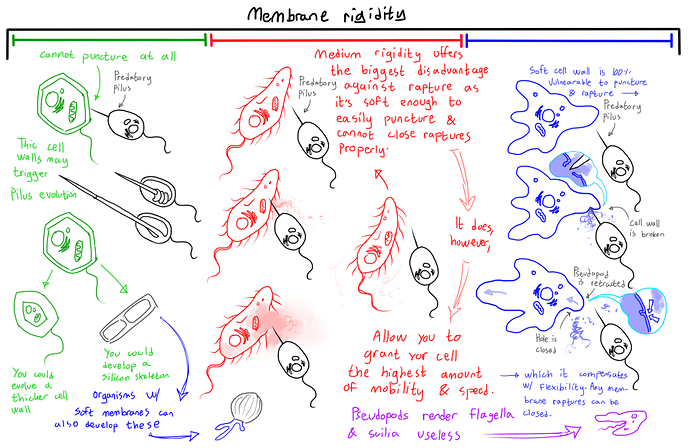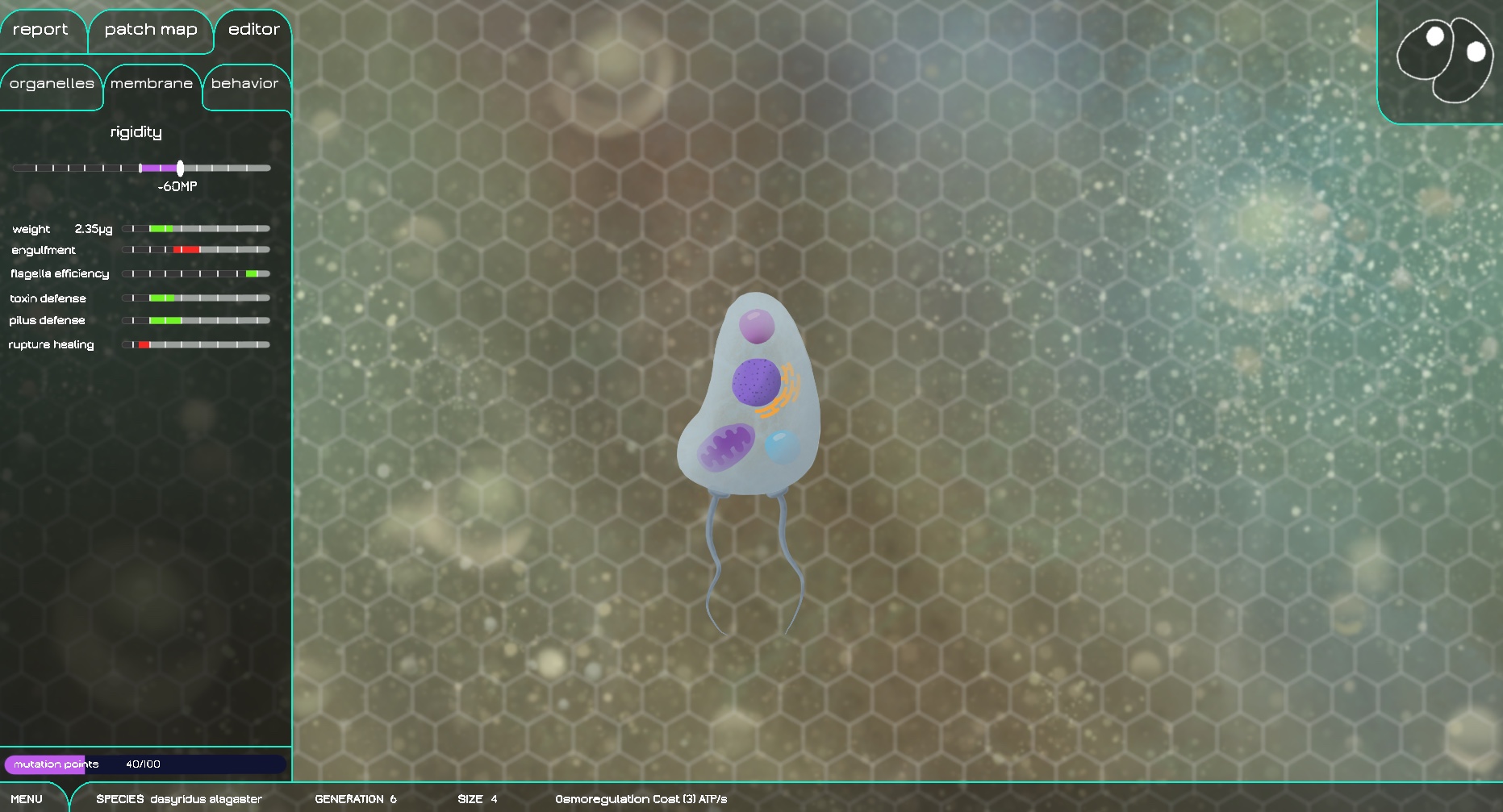Hi, bellow you will find a general description of cell membranes and walls. I tried to limit the details to things useful for the game development and put forward some game-related characteristics and ideas. If I went too deep or neglected some details do not hesitate to ask questions and I will be happy to answer.
- Membrane(s)
1.1 Membrane fluidity
Membranes may appear as a solid barrier isolating the organelles from the outside world but this limit is actually quite flexible and can almost be considered a fluid. This fluidity is necessary for the cell as it allows the membrane to flex and create vacuoles for phagocytosis. The fluidity of a membrane is strongly influenced by its composition and is usually adapted to the cell’s environment.
Temperature is the main factor when it comes to cell membrane fluidity or stiffness. As a rule of thumb the higher the temperature, the more fluid a membrane becomes, up to the point where it breaks from thermal stress. The opposite is also true and a membrane becomes stiffer the colder it is, eventually impeding the cell’s ability to exchange nutrients and metabolic trashes with its environment. It can become so cold that ice crystals may form inside a cell and, much like a knife, breach the membrane.
In this regard micro and macro organism have a specially tailored membrane composition. Organisms with stiffer cell membranes are usually living in hotter conditions and those with a more fluid membrane tend to be living in colder climates. This, overall means that they have a comparable membrane fluidity but at wildly different temperatures.
The best examples would be extremophiles: thermophile bacteria were found to have “cheated” the usual composition and added special lipids to their membranes that stiffen it a lot, allowing it to tolerate the extreme temperatures found near black smokers. Its membrane would probably be solid at room temperature. On the other end of the spectrum there is an arctic fish that live in waters that can reach -4 degrees Celsius and, yet, does not freeze. It membranes are very fluid and would likely easily break if brought near a black smoker but given the low temperature, it is just fine. It even evolved a natural antifreeze agent that clumps with tiny ice crystals forming in its blood and cells and stops them from growing to a dangerous size.
1.2 Membranes
Some organisms have more than a single membrane. Bacteria have what could be called a triple-membrane as it is composed of an inner lipid bilayer, an intermediate layer of peptidoglycans and another external lipid bilayer. All these layers serve as additional protection and serve as an anchor point for some external structures like flagella.
I do not know much about organisms with multiple membranes however and this is pretty much it from the top of my mind.
- Cell walls
2.1 Without cell wall
Most organisms without a cell wall are either amoeba-like or have an internal cytoskeleton made from protein fibers to keep their shape. The greatest disadvantage of a “naked” membrane is osmoregulation as the entirety of the membrane is exposed to the environment. They are, however, those that can engulf the biggest preys and can achieve some motility using pseudopods.
2.2 Cellulose wall
Most common in plants, trees and algae cellulose walls are extremely resilient to internal pressure. If its osmoregulation fails and it would normally burst, the cellulose wall will keep the cell intact for quite some time (I once ran an experiment where we put some carrot cells in distilled water and it took it about 10 minutes before I saw some cells burst). It is also very resilient to physical damage and, to a certain extent, chemical damage. However the right enzyme can make short work of cellulose, take the fungi decomposing wood as an example.
2.3 Chitin wall
Found in fungi, chitin is kind of a middle ground. It does offer some mechanical resilience, it is kind of hard to break down without the right enzymes but is otherwise unremarkable as far as I know. It is very much not my area of expertise though and I am probably missing some details.
2.4 Silica shell
Not a true wall per say but could be considered like it in game mechanics. It allows for some of the sturdiest protection while not stopping light for photosynthesis. A large amount of organisms with a silica shell have spikes and other defensive structures. Ironically most of the organisms with a silica shell move like amoeba, using pseudopods protruding from tiny holes and openings in the shell. The main disadvantage of a silica shell is sheer weight and they have a hard time not sinking. Another disadvantage is the raw material needed to produce this shell and silica can sometimes be a limiting nutrient during blooms. Art note: though most micro-organisms aren’t incredibly cute or something, Diatoms, Silicoflagellates and radiolaria could be called artists and are quite pretty.
2.5 Calcium carbonate shell
There are two types of calcium carbonate shells, those made out of calcite and those made out of aragonite. I do not know if this is too much detail but I will go ahead anyway. Both are quite sturdy and also heavy but most organisms with such shells also have flagella that allows them not to sink or control said sinking. Calcite is most resilient to chemical stress and can stand lower pH than aragonite. Aragonite is, on the other hand, more resilient to physical stress than calcite and relatively sturdier overall. Both have a huge advantage and a corresponding disadvantage. The advantage is that calcium carbonate is extremely plentiful and is almost never a limiting factor to their growth. The disadvantage is that there is a limited depth at which calcium carbonate starts dissolving. At a depth between 4000 to 5000 meters, calcium carbonate dissolves completely and no organisms with a calcium carbonate shell can survive bellow said depth.
- Graph
Here is a little graph to summarize it all and a few of my ideas on how it could be implemented in the game.
| Membrane/Wall |
Advantages |
Disadvantages |
Example Organisms |
| Simple Membrane |
None, standard |
None, standard |
Euglena, Amoeba |
| Double Membrane |
Chemical and physical resilience |
Maintenance costs, slower exchange with environment |
Most if not all bacteria |
| Without Wall |
Easy phagocytosis (larger engulf radii), mobility through pseudopods |
High osmoregulation cost, vulnerable to physical and chemical damage |
Amoeba, most animal cells, choanoflagellates |
| Cellulose Wall |
Low osmoregulation cost, highly resilient to chemical and physical damage |
Very weak to specific enzymes, low mobility, slower exchange with environment |
Plants, algae |
| Chitin Wall |
More resilient to most damage |
Lower mobility, slower exchange with environment |
Fungi, Yeasts |
| Silica Shell |
Most resilient to physical and chemical damage, lower cost of spiky defenses, very pretty |
Very heavy, increases sinking rate dramatically / lowest mobility, increases cost of mobility-related organelles |
Silicoflagellates, radiolarian, diatoms |
| Calcium Carbonate Shell |
Resilient to most physical damage and slightly resilient to chemical damage |
Heavy, slightly increased rate of sinking / low mobility, slower exchange with environment |
Dinoflagellates, Coccolitophores |
Don’t hesitate to ask questions!




